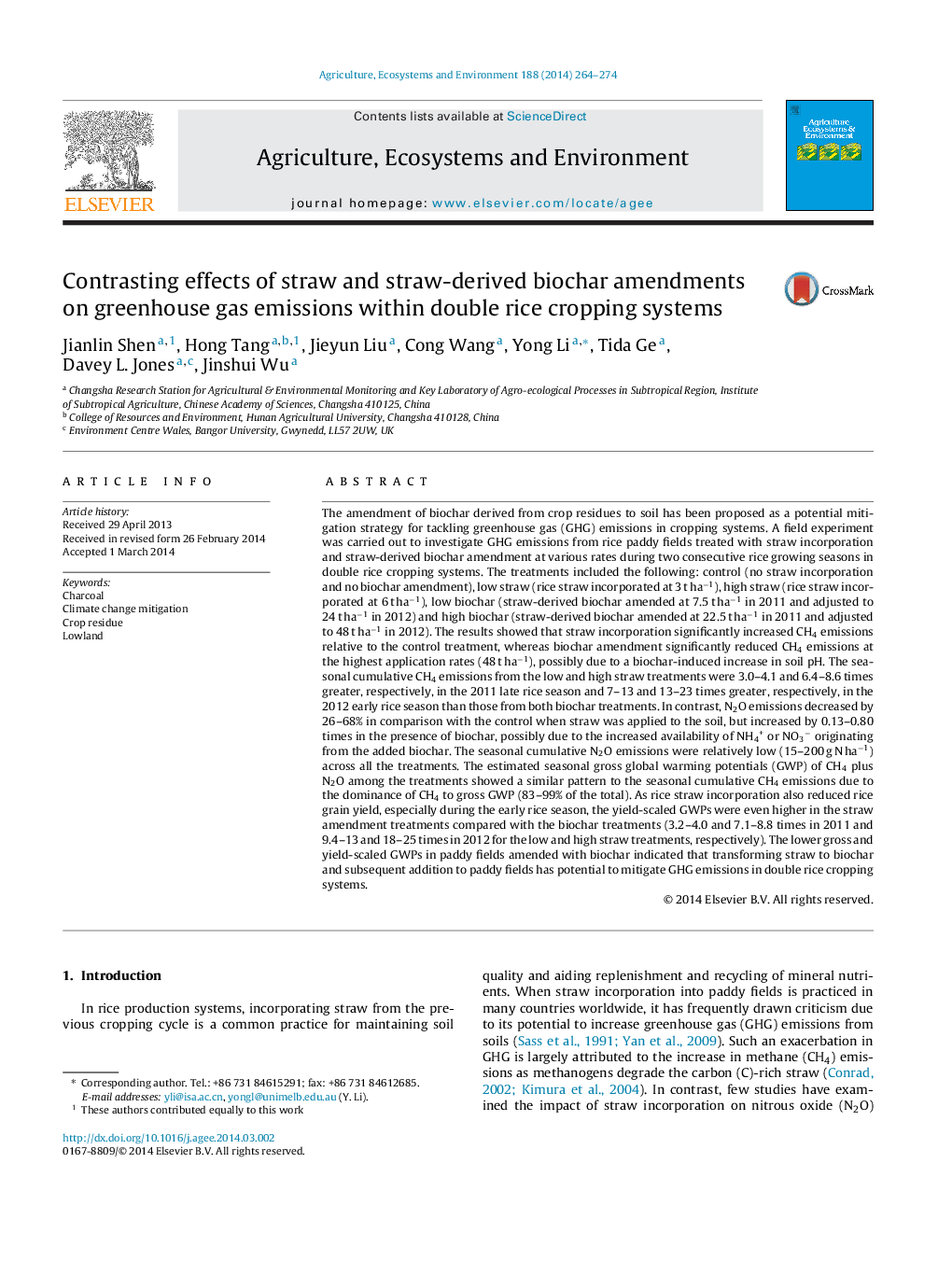| کد مقاله | کد نشریه | سال انتشار | مقاله انگلیسی | نسخه تمام متن |
|---|---|---|---|---|
| 8487891 | 1552064 | 2014 | 11 صفحه PDF | دانلود رایگان |
عنوان انگلیسی مقاله ISI
Contrasting effects of straw and straw-derived biochar amendments on greenhouse gas emissions within double rice cropping systems
ترجمه فارسی عنوان
اثرات متقابل اصلاحات زیست تخریب کاه و کاه در تولید گازهای گلخانه ای در سیستم های برداشت دو برنج
دانلود مقاله + سفارش ترجمه
دانلود مقاله ISI انگلیسی
رایگان برای ایرانیان
کلمات کلیدی
زغال چوبی، کاهش تغییرات اقلیمی، بقایای محصول، پایین زمین،
موضوعات مرتبط
علوم زیستی و بیوفناوری
علوم کشاورزی و بیولوژیک
علوم زراعت و اصلاح نباتات
چکیده انگلیسی
The amendment of biochar derived from crop residues to soil has been proposed as a potential mitigation strategy for tackling greenhouse gas (GHG) emissions in cropping systems. A field experiment was carried out to investigate GHG emissions from rice paddy fields treated with straw incorporation and straw-derived biochar amendment at various rates during two consecutive rice growing seasons in double rice cropping systems. The treatments included the following: control (no straw incorporation and no biochar amendment), low straw (rice straw incorporated at 3 t haâ1), high straw (rice straw incorporated at 6 t haâ1), low biochar (straw-derived biochar amended at 7.5 t haâ1 in 2011 and adjusted to 24 t haâ1 in 2012) and high biochar (straw-derived biochar amended at 22.5 t haâ1 in 2011 and adjusted to 48 t haâ1 in 2012). The results showed that straw incorporation significantly increased CH4 emissions relative to the control treatment, whereas biochar amendment significantly reduced CH4 emissions at the highest application rates (48 t haâ1), possibly due to a biochar-induced increase in soil pH. The seasonal cumulative CH4 emissions from the low and high straw treatments were 3.0-4.1 and 6.4-8.6 times greater, respectively, in the 2011 late rice season and 7-13 and 13-23 times greater, respectively, in the 2012 early rice season than those from both biochar treatments. In contrast, N2O emissions decreased by 26-68% in comparison with the control when straw was applied to the soil, but increased by 0.13-0.80 times in the presence of biochar, possibly due to the increased availability of NH4+ or NO3â originating from the added biochar. The seasonal cumulative N2O emissions were relatively low (15-200 g N haâ1) across all the treatments. The estimated seasonal gross global warming potentials (GWP) of CH4 plus N2O among the treatments showed a similar pattern to the seasonal cumulative CH4 emissions due to the dominance of CH4 to gross GWP (83-99% of the total). As rice straw incorporation also reduced rice grain yield, especially during the early rice season, the yield-scaled GWPs were even higher in the straw amendment treatments compared with the biochar treatments (3.2-4.0 and 7.1-8.8 times in 2011 and 9.4-13 and 18-25 times in 2012 for the low and high straw treatments, respectively). The lower gross and yield-scaled GWPs in paddy fields amended with biochar indicated that transforming straw to biochar and subsequent addition to paddy fields has potential to mitigate GHG emissions in double rice cropping systems.
ناشر
Database: Elsevier - ScienceDirect (ساینس دایرکت)
Journal: Agriculture, Ecosystems & Environment - Volume 188, 15 April 2014, Pages 264-274
Journal: Agriculture, Ecosystems & Environment - Volume 188, 15 April 2014, Pages 264-274
نویسندگان
Jianlin Shen, Hong Tang, Jieyun Liu, Cong Wang, Yong Li, Tida Ge, Davey L. Jones, Jinshui Wu,
